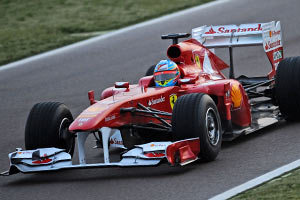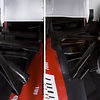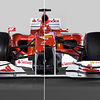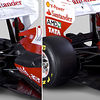Ferrari F150

Active: 28-01-2011 - 2011
Team: Scuderia Ferrari SpA
Team: Stefano Domenicali (TP), Mario Almondo (Director of Operations), Aldo Costa (TD), Nicolas Tombazis (CD), Luca Marmorini (HE)
Drivers: Fernando Alonso (5), Felipe Massa (6)
The F150 is Ferrari's 57th Formula One car, built under the internal codename of 662. The new F150 was named as such because the Maranello marque chose the name as a tribute and celebration of the one hundred and fiftieth anniversary of the Unification of Italy.
The most important changes compared to the Ferrari F10 are certainly due to regulation changes. As far as the rule changes from 2010 are concerned, the double diffuser and the blown rear wing are banned, as is the use of apertures in the front part of the floor, while the use of a hydraulically controlled adjustable rear wing has been introduced. After an unofficial agreement saw its use banned for 2010, KERS is back, thanks partly to the increase in the car’s minimum weight and stricter controls on weight distribution figures. The Scuderia has decided to incorporate this technology on the F150 and this has had a significant impact on the design, also taking into account that the dimensions of the fuel cell are very different to what they were in 2009. Also significant are changes dictated by the introduction of stricter safety requirements in terms of crash-tests, cockpit area protection and wheel-retaining cables for use in accidents.
A second crucial factor for the car's design is the change of tyre supplier. After 13 years of Bridgestone tyre partnership, Ferrari switches to Pirelli which has taken on the role as the sole tyre supplier in Formula One
Technical analysis
Side by side comparison of the F10 and the F150 quickly shows that the 2011 competitor has a higher monocoque and nose. As such, the front suspension has been drastically modified to connect the wheels to the chassis. All wishbones are now more angled upwards towards the chassis attachment points. Additionally, the front wishbones also have an increased angle when looking at their position from above the car.
The sidepods meanwhile have smaller air inlets, more alike those on the McLaren MP4-25. The air inlet in the airbox has been modified as well, now having a more rounded shape to be less influenced by turbulence caused by the driver's helmet.
At each side of the driver, the sidepods are also slightly higher then in 2010 as internal components have been relocated to make room for the KERS system. Batteries for this system have been located below the fuel tank. More towards the back however, the sidepods slope down quickly, creating a very tiny rear cross section. Here, Ferrari have had to redesign the rear suspension. While the push rod was retained, its attachment point to the chassis was moved forwards considerably, just like the frontal wishbones which are now much longer as well.
Also due to regulation changes, the shark fin engine cover has been replaced by a more conventional one, while the movable rear wing has been introduced.
Overall, the car appears to have been shortened a bit, whereas Ferrari also claim to have redesigned the complete braking system in cooperation with their long term partner Brembo. The car's rear diffuser is again a blown diffuser just like on the F10 during the second half of the season, albeit considerably simpler as the doubled decks were banned. The height increase of the nose and monocoque is also the result of this diffuser change, as the team try to regain the lost downforce.
As the freeze on engine performance development is still ongoing, there have been no actual modifications to the 056 engine, but that does not mean Ferrari’s engine specialists have been idle. Work has gone into improving reliability, working especially on the pneumatic front, as well as on reducing costs. Furthermore, the reintroduction of KERS has led to a substantial change in the architecture of the front end of the engine, with modifications to the drive shaft system of the KERS itself and the crankshaft and this has led to changes to the cooling and lubrication systems. The kinetic energy recovery system, designed by Ferrari, has been produced in conjunction with MTS and Magneti Marelli and was fine tuned based on experience acquired in 2009, with the aim of reducing its size and weight, while maintaining, in accordance with the regulations, the maximum useable power and its useage cycle over one lap.
Chassis
Chassis: Monocoque, carbon-fibre and honeycomb composite structure
Gearbox: Ferrari, semiautomatic sequential longitudinal 7-speed quick-shift gearbox. Electronically controlled
Differential: Limited-slip
Brakes: Brembo ventilated carbon-fibre disc brakes
Suspension: Independent suspension, push-rod activated torsion springs front and rear
Weight: 640 kg (incl water, lubricants and driver)
Wheels: BBS Wheels (front and rear): 13”
Engine
Designation: Ferrari type 056
Cylinder configuration: Naturally espirated 90° V8
Cylinder block: and cast aluminium V 90°
Valvetrain: 32 valves with pneumatic distribution
Displacement: 2398 cm³
Piston bore: 98 mm
Weight: > 95 kg
Injection: Electronic injection and ignition
Fuel: Shell V-Power
Lubricant: Shell Helix Ultra







